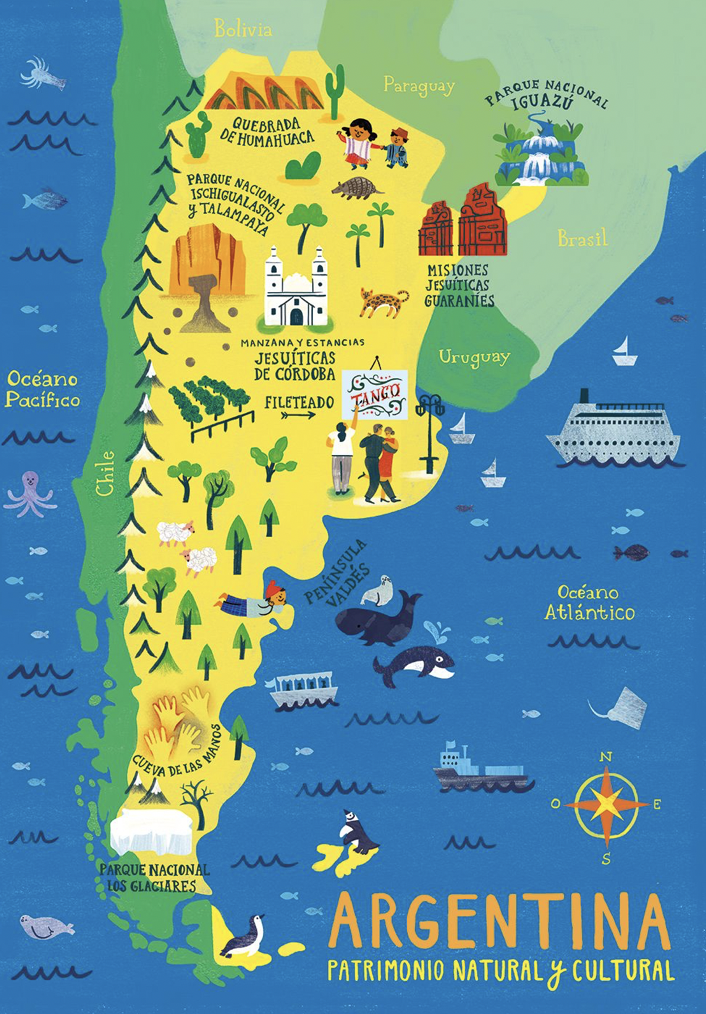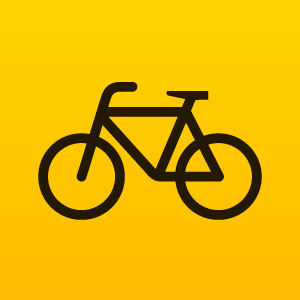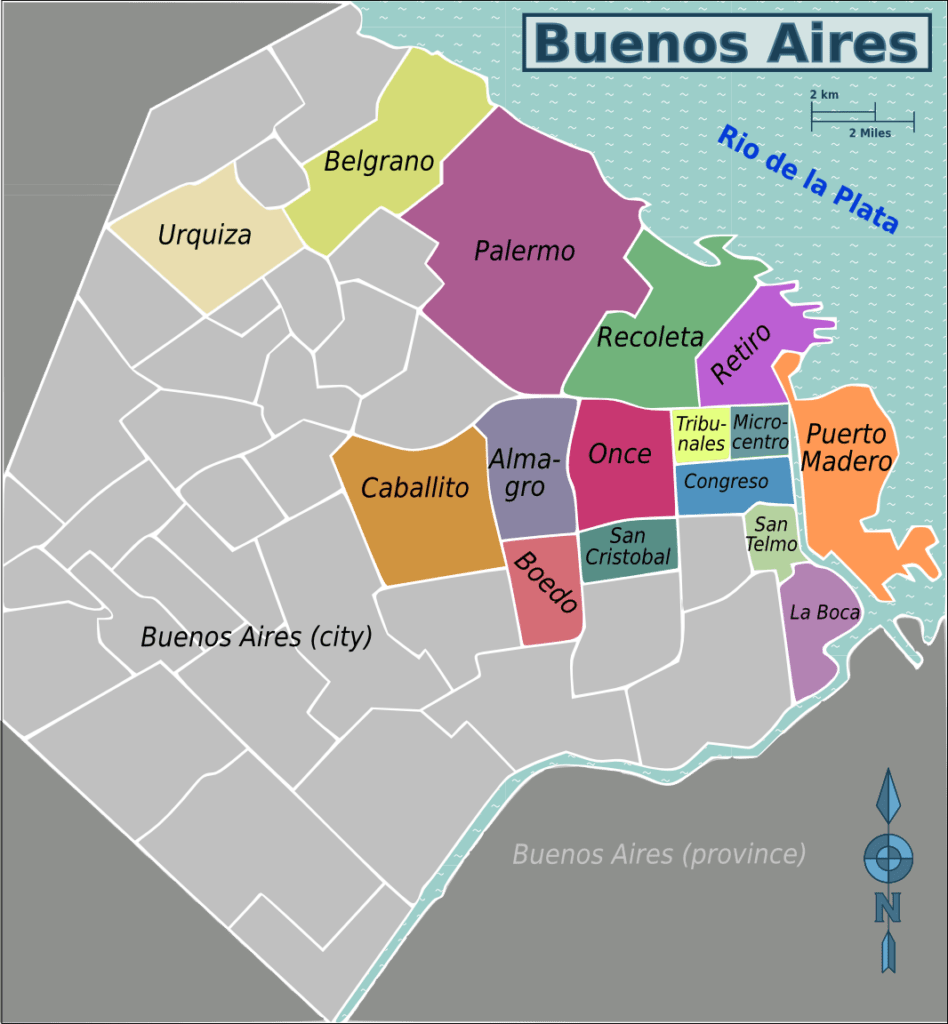Argentina is probably the most “European” country in Latin America. It stretches from the Tropic of Capricorn towards Antarctica. From Patagonian mountains, steppes, and glaciers to deserts, tropical jungles, vineyards, and modern architecture. From delicious steaks and good wine to football “religion” and diverse nature.
Before you pack your bags and visit this country, I have got some traveling insights to share with you, ranging from the best season to visa options and must-have apps to the best places for staying!

Best season to go to Argentina
The best time to visit Argentina is springtime, which spans from October to mid-December. It’s great for both visiting Buenos Aires and Patagonia.
Alternatively, April to mid-June is autumn, so it is a great time to visit as you will be able to avoid the peak season costs.
Temperature in Argentina
Visa options in Argentina
There are some visa-exempt countries, and if you have a visa from these countries, you can stay in Argentina for up to 90 days without having to apply for a visa. The visa-exempt countries include:

If you are from any other country, you need a passport that’s valid for at least six months as well as a return ticket. There are various short-term visas available, such as:
- Tourist visa – for people who are visiting for recreational purposes
- Business visa – for people who are visiting for work
- Medical treatment visa – for people who need to receive a healthcare treatment
- Media/journalist visa – for people who are covering some events on media
- Religious visa – for people who are members of an official religious order
Source: https://visaguide.world/south-america/argentina-visa/
Sockets and Plugs to use in Argentina
Type C and I plug


There are two associated types of plugs, including types I and C. Plug C has two round pins while plug I has three flat pins installed in a triangular form. Also, the country operates of 220V power outlet and 50Hz.
Currency & Exchange rate
Argentinian Peso (ARS) is the currency in Argentina.
The official exchange rate of the Argentinian Peso (ARS) against top currencies includes:
| Currency | Amount in ARS |
| 1 USD | 147 |
| 1 EUR | 144 |
| 1 GBP | 164 |
| 1 USD | 147 ARS |
| 5 USD | 735 ARS |
| 10 USD | 1470 ARS |
| 20 USD | 2941 ARS |
| 100 USD | 14706 ARS |
Official Exchange Rate Converter
*Note: Here is the webpage with the market price – Dollar Blue (ARS_PA) rate, which is almost 2x higher than the official one and you can easily find people on main streets exchanging you USD or EUR based on that rate.
Fee-free ATM in Argentina
ATM charges are incredibly high in Argentina. Moreover, they give exchange your money with the official exchange rate. For this reason, it’s essential to keep an eye open for fee-free ATMs in the country, and at the moment, only Scotiabank is offering free cash withdrawals. Another option is to use Western Union.
But I would better suggest bringing cash (preferably $ big notes) and exchanging it for almost 2x of the official rate. Just be careful and don’t exchange too much money at once.
Also, I would recommend using online banks like Wise, which allows you to take money from ATMs abroad without commission (2 times per month).
*Note, if ATM is asking for a conversion rate, use the local currency, as your bank probably would provide a better conversion rate, than ATM.
Cost of living in Argentina
We all don’t like overpaying. I tried to collect the table with prices for the most common things when visiting/living in Argentina.
| Local price (USD) | Fair price (USD) | Tourist price (USD) | |
| Western breakfast with a coffee | 5 | 5-10 | 10+ |
| Inexpensive Dinner (1 simple meal + drink) | 5 | 5-15 | 15+ |
| Steak | 7-10 | 10-15 | 15+ |
| Bottle of water (0.5l) | 0.5 | 0.5-1 | 1+ |
| Bottle (0.3l) of beer in a shop | 1 | 1-3 | 3+ |
| Bottle (0.3l) of beer in a bar | 1.5 | 1.5-3.5 | 3.5+ |
| Botte of average (good) Argentinian wine (2021) | 3 | 5 | 10+ |
| 1-bedroom apartment (per month) | 300 | 300-500 | 500+ |
Mobile Apps you need in Argentina
Mobile apps have made our lives more accessible by improving communication, ordering food, and commuting. Here are some of the must-have apps in Argentina:
Taxi:
Uber

Food:
Rappi

Transportation:
BA Ecobici

Marketplaces:
Mercado Libre

Money exchange:
Western Union

- Rappi – it’s an app for ordering groceries and food
- Mercado Libre – it’s an equivalent of Amazon, eBay, and Craigslist
- Western Union – to get better currency exchange rates
- BA Ecobici – it allows you to get orange bikes for free and is suitable for shorter riders
Argentina Phone operators
Some of the most popular phone operators include Claro, Telefonica Movistar, and Telecom Personal.
All of them have reliable phone and data plans and it’s recommended that you check the available plans on the official websites.
Another option is to use eSim like Airalo.
How to get from Buenos Aires airports
Ministro Pistarini International Airport, Ezeiza (EZE)
Located 32km from the city center. The journey usually takes up to an hour.
Public Bus (line 8): $0.72 + SUBE card ($1.8), takes up to 2h to get to city center
Suttle bus: will cost around $12
Taxi: will cost around $30. Check the price before you go
Jorge Newbery Airport, known as Aeroparque (AEP)
Airport, located in the city, just 2 km northeast from Buenos Aires city center.
Public Bus (n160): $0.72 + SUBE card ($1.8)
Taxi: will cost around $10-25, depending on where you go. Confirm the price before you go.
El Palomar (EPA)
Located around 18km from the city, the journey usually takes around 30min.
Public Bus: Line 53, 182, 252, 320, 236, 286, 634. Will cost $0.72 + SUBE card ($1.8)
Taxi: will cost around $28. Check the price before you go
Train: costs just around $0.5 + SUBE card ($1.8)
*You’ll need a SUBE travel card to use the bus or train
Is Argentina safe?
Unfortunately, because Argentina has economical issues and is also a tourist country, which automatically creates higher chances of snatching and theft. For this reason, be cautious, don’t walk alone at night, and look after your phone and valuables on the street.
In addition, always wear your backpack rather than dangling it in your arms.
Travel Insurance
If you are traveling, I would say insurance is a must. I have seen so many times when people get injuries and health problems, and their relatives/friends needing to organize fundraising campaigns for the treatments.
The health system here is very expensive. So it’s better to be safe than sorry. Hopefully, you won’t need to use it.
I personally buy for $45/month (can have a daily option) SafetyWings travel insurance. That gives me peace of mind. It has $250 deductible, with $250 000 max limit. I had 2 claims, and both of them got covered.
*This is affiliate link. Meaning I will get a commission if you use it. But as I mentioned before I am using this insurance myself.
Buenos Aires co-working and co-living places
Argentina FB Groups & Community
Where to stay in Buenos Aires (map)
- Retiro – this is a waterfront district that has all the amenities at a close distance. There are two bus and train stations, and it is away from the hustle and bustle
- San Telmo – it’s one of the most affordable areas with a bohemian aesthetic. Also, if you visit on Sunday, you can enjoy the flea market and street performances
- Palermo Soho – it’s one of the most stylish and picturesque parts of the city and is perfect for boutique shopping and enjoying the vibrant nightlife
- Recoleta – it’s the affluent part of the city, and there is a huge Patio Bullrich mall if you want to shop.

Things to do in Argentina
Here is the list of things you can do in Argentina:
7, 10, and 14 days Argentina itinerary
It’s impossible to see Argentina within 1-2 weeks. But I tried to put the best highlights you can do.
- Day 1 – arrive in Buenos Aires. Explore Puerto Madero, La Boca and Montserrat.
- Day 2 – go on a bicycle or walking tour of Buenos Aires. Avenida de Mayo, Retiro, Recoleta and Palermo Soho.
- Day 3 – fly to El Calafate. Explore a little but cozy town, and go to an authentic restaurant.
- Day 4 – go on the Periot Moreno Glacier tour.
- Day 5 – fly to El Chalten. Go for the Mirador Los Cóndores hike which is only 1h from the city.
- Day 6 – go for a full-day hike to Laguna de Los Tres
- Day 7 – go for another hike to Laguna Torre and at the end of the day either take a 24h bus or plane (from El Calafate) to Bariloche.
- Day 8 – explore Bariloche & take a boat tour of Tristeza Sound
- Day 9 – rent a car or (bike) and explore the Ruta de los Siete Lagos – a stunning drive through the area’s seven lakes
- Day 10 – go to Mendoza, and try the famous Malbecs wine
- Day 11 – fly to Salta
- Day 12 – explore Salt Flats and Quebrada de Humahuaca
- Day 13 – fly from Salta to Puerto Iguazu
- Day 14 – explore Iguazu Falls (full-day) and head to your next destination (would recommend the Brazilian part of Iguazu falls)
COVID-19 rules in Argentina
Currently, the borders are open to everyone, and non-residents have to fill out a sworn statement within 48 hours before they travel to the country and show insurance proof to cover the treatment cost in case they contract COVID-19. As far as the testing and vaccination requirements are concerned, there are none!
Source: https://www.dfa.ie/travel/travel-advice/a-z-list-of-countries/argentina/
Good to know
- Make sure you try out Argentinian steak
- Come with cash and exchange with the “Blue dollar” rate
- Learn some basics of Spanish
- Always go for budget airlines rather than long-distance busses to save time (rates are similar)
- Try to watch a football game while in Argentina. Football is a religion here
- Try Argentinian wine. It’s cheap and good
- Buy the SUBE card for public transport
Essential basic words to know in Argentina
Hola – Hi
Sí – Yes
No – No
Adiós – Goodbye
Buenos dias – Good morning
Buenas tardes – Good afternoon
Buenas noches – Good evening
Por favor – Please
Gracias – Thank you
Habla inglés? – Do you speak English?
No entiendo – I don’t understand
Socorro! – Help!
Check out more travel guide to Bolivia, South of Thailand, Colombia, Egypt, Tenerife, Bali and other amazing Ultimate Travel Guide.




